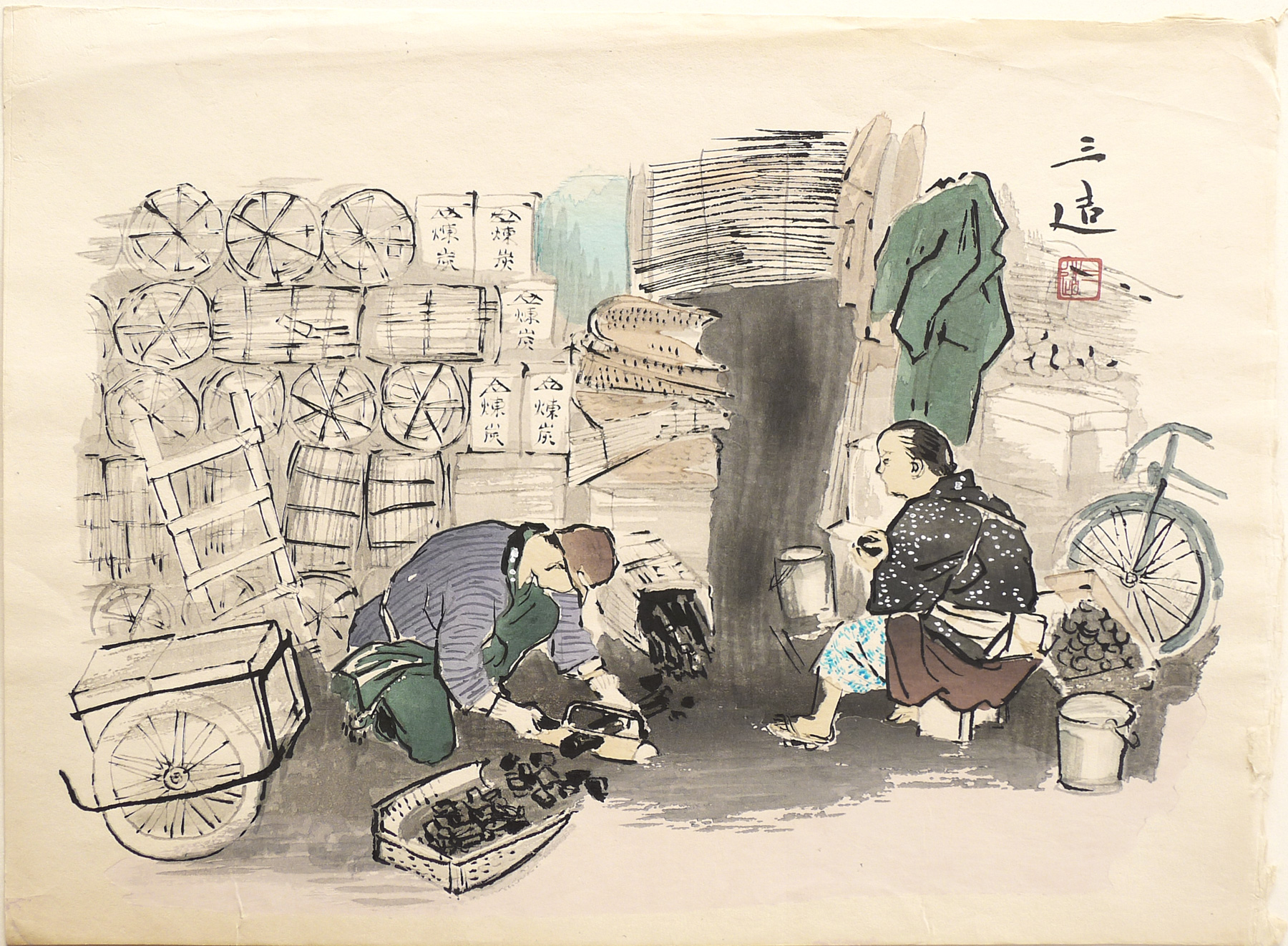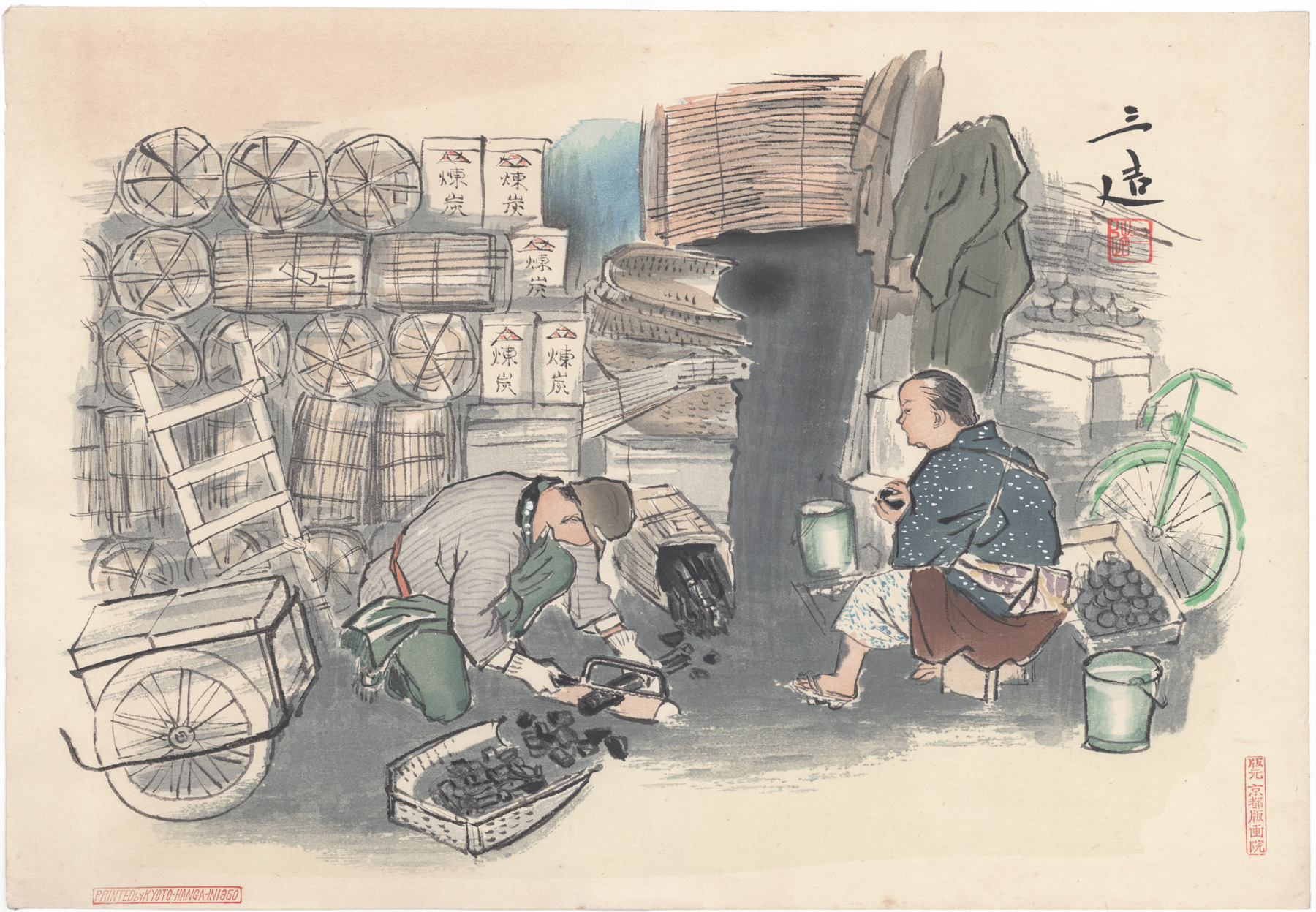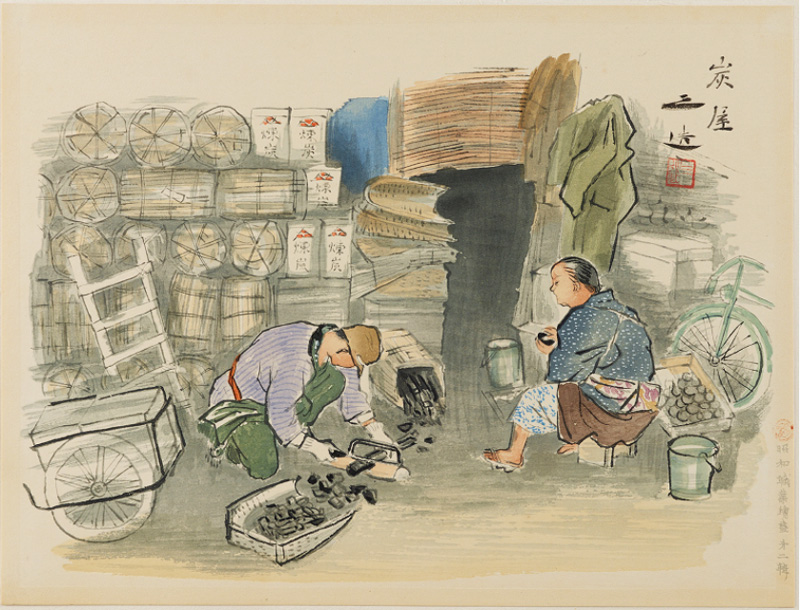About This PrintBy the time this print, showing a charcoal seller cutting charcoal logs into pieces, was issued during the Pacific War, Japanese homes and small industry were demanding more and more charcoal, adding to the degradation of Japan's large forests.
Both of this collection's prints are post-war second editions by the publisher Kyoto Hangain, of the pre-war design originally issued by the publisher Nishinomiya Shoin in 1939-1941 (see image below), as the fourteenth print in the second series of Occupations of the Shōwa Era in Pictures. The top print above IHL Cat. #988, although lacking any publisher's mark, is a post-war release by Kyoto Hangain, as is the bottom print IHL Cat. #1317, dated 1950, carrying the seal of Kyoto Hangain in the margin. As can be seen, there are small variations in the colors used on the two prints.
First edition issued by Nishinomiya Shoin, 1939-1941. Note the presence of the prints title 炭屋 on this original release not present on this collection's second edition prints.
Artist's Commentary from the First Edition
[First Edition, 1939-1941, published by Nishinomiya Shoin]
[Translation taken from Memories of Shōwa: Impressions of Working Life by Wada Sanzō,
Maureen de Vries and Daphne van der Molen, Nihon no hanga, 2021, p. 54.]
The Charcoal Vendor What would be the reason for the mysterious phenomenon nowadays of the upper-class voices on the street supporting the government, while the lower-class are concentrating all their energy on rice and charcoal? And everywhere you go you hear the polite phrase 'The world has become a strange place, don't you think.'
As autumn turns to winter, people's eyes are drawn more acutely to rice and charcoal with each passing day. And people go crazy over charcoal to the extent that a lump that before would have seemed completely insignificant to them, now looks like a black diamong.
Some people even pine is prison because of it.
Because of the current situation, almost every day new substitutes are invented and them substitutes for substitutes...
I wonder what on earth will happen to Japan's forests and mountains. |
About the Series "Occupations of Shōwa Japan in Pictures"
Sources: website of Ross Walker Ohmi Gallery http://www.ohmigallery.com/DB/Artists/Sales/Wada_Sanzo.asp and website of USC Pacific Asian Museum "Exhibition - The Occupations of Shōwa Japan in Pictures: The Woodblock Prints of Wada Sanzō"
Note:
My special thanks to Shinagawa Daiwa, the current owner of Kyoto Hangain, for providing the below information (in a series of emails in July 2014) about Nishinomiya Shoin and Kyoto Hangain, both businesses started by his father Shinagawa Kyoomi. Shinagawa's current website can be accessed at http://www.amy.hi-ho.ne.jp/kyotohangain/ Wada’s major contribution as a woodblock print artist came through his 72 print 3-part series Occupations of Shōwa Japan in Pictures (Shōwa shokugyō e-zukishi), also translated as Occupations of the Shōwa Era in Pictures and Japanese Vocations in Pictures. The three part series was started during the Pacific War (1937-1945) in September 1938, was then interrupted by war shortages in 1943, and was restarted again after the war in January 1954. This series was a labor of love for Wada and he brought together woodblock print printers and carvers in Nishimomiya near Kobe to work on this project.
The war era prints were published by Wada through an old books store, Nishinomiya shoin 西宮書院 run by Shinagawa Kyoomi planned a total of 100 designs, with two prints being issued each month. Wada's designs for the prints were rendered in watercolor and the finished prints beautifully captured the look-and-feel of those original watercolors. The series was an immediate hit, but was suspended after 48 prints (issued in two series) in 1943 due to war shortages. After the war, the series was continued by the same publisher, Shinagawa Kyoomi, who had opened a new business in Kyoto, which he named Kyoto Hangain 京都版画院. (Shingawa's business in Nishinomiya had burned down during WWII.) At first Kyoto Hangain published re-prints of the earlier prints, but they went on to publish a third series of 24 prints, working closely with Wada, titled Continuing Occupations of Shōwa Japan in Pictures between November 1954 and September 1956.1 The post-war prints were popular with the Occupation's "deep-pocketed" military and civilian personnel and the series was "featured in an article of the Tokyo edition of the United States military newspaper Stars and Stripes."2 Shinagawa also published a six print portfolio in the 1950s titled Japanese Life and Customs, consisting of six of the prints from the earlier two series in a reduced chuban size, which is also part of this collection. Occupations of Shōwa Japan in Pictures has been praised for showing “the complexity of Shōwa society…. capture[ing] the pulse of Japanese life during the tumultuous decades of the 1930s, 1940s and 1950s”3 and condemned as providing a “visual message of subtle or blatant propaganda in support of government-sponsored ideas.”4 It is interesting to see how the commentary, written by the artist, that accompanied each print in the pre-war releases was softened for the post-war re-issues by Kyoto Hangain. All references to soldiers being away from home (as Japanese armies were marching through Asia when the series was originally released) or references to Imperial Japan have been stripped away and the commentary becomes innocent, folk-like and appealing to the post-war occupying forces. (For example, see the prints Women Weavers and Picture Card Show which provide the artist's original commentary and a full transcript of the English text attached to the folders of the post-war re-issued prints.)
1 Keizaburo Yamaguchi gives the publication dates of the post-War series as January 1954 through autumn 1958. (Ukiyo-e Art 16, 1967): 39-42. 2 "Out of the Dark Valley: Japanese Woodblock Prints and War, 1937-1945," Kendall H. Brown,p. 82 appearing in Impressions, The Journal of the Ukiyo-e Society of America, Inc., Number 23, 2001.3 Pacific Asia Museum website http://www.pacificasiamuseum.org/_on_view/exhibitions/2004/occshowa.aspx 4 Light in Darkness: Women in Japanese Prints of Early Shōwa (1926-1945), Kendall H. Brown, et. al., Fisher Gallery, University of Southern California, 1996, p. 18.
Print Details| IHL Catalog | #988, #1317 | | Title/Description | 炭屋 - Charcoal Seller [number 14] | | Series | Occupations of Shōwa Japan in Pictures, Series 2 (also seen translated as "Compendium of Occupations in the Shōwa Era" and "Japanese Vocations in Pictures")
Shōwa shokugyō e-zukushi 昭和職業繪盡 (also seen written as 昭和職業絵尽し and
昭和職業繪盡し), dainishū (第二輯) | Artist
| Wada Sanzō (1883-1967)
| Signature
| 三造 Sanzō | | Seal | "Sanzō" - seal of artist | | Publication Date | 1950 (originally 1939-1941)
| | Publisher | #988 no publisher's mark or seal but Kyoto Hangain 京都版画院
#1317 seal of the publisher Kyoto Hangain in both English and Japanese | | Edition | Two second editions of the print first published by Nishinomiya shoin in 1939-1941. As originally issued my Nishonimiya shoin this print was the 14th in series 2. It is believed that all the pre-WWII woodblocks for this series were destroyed in Allied air raids in 1945 and that all post-WWII impressions by Kyoto Hangain, the business started by Daiwa Shinagawa the owner of Nishomiya shoin after WWII, were made from re-cut blocks. | | Impression | excellent | | Colors | excellent | | Condition | good - minor creasing/wrinkling; stray printers marks bottom margin
| | Genre | shin hanga
| | Miscellaneous | originally released by Nishinomiya Shoin as print number 14 in series 2 | | Format | dai-ōban | | H x W Paper | IHL Cat. #988 - 11 7/8 x 15 3/4 in. (30.2 x 40 cm)
IHL Cat. #1317 - 11 x 15 7/8 in. (27.9 x 40.3 cm) | | H x W Image | | | Collections This Print | Himeji City Museum of Art Ⅲ-184-14 (dated "1939~1940年"); Artizon Museum (dated 1940-1941); Fukuoka Art Museum (dated 1939-1941) | | Reference Literature | Memories of Shōwa: Impressions of Working Life by Wada Sanzō, Maureen de Vries and Daphne van der Molen, Nihon no hanga, 2021 |
last revision:8/9/2021 6/7/2020 12/5/2018 |







